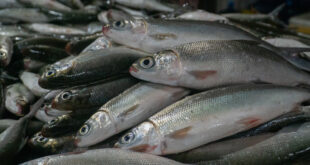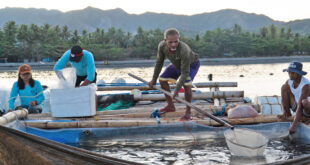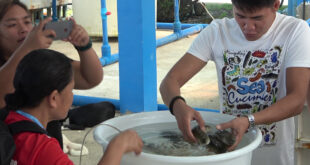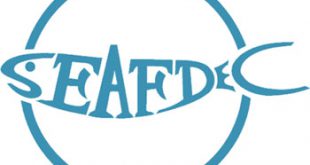 Technology Description
Technology Description
Tilapia has been dubbed the “aquatic chicken” because it grows fast, breeds in captivity easily, and the technology for its propagation and culture requires little input. Hatcheries can readily supply the seedstock that the tilapia farming industry needs.
Hatcheries are of three types: concrete tanks, which give the highest production; hapa netcages in lakes, the second highest; then ponds.
| Technology profile: | |
|
(1) Get good breeders (50-250 g) from reputable hatcheries; or, raise them from the fry stage until they mature in 3 months. For the latter, breeding trials at SEAFDEC/AQD have shown that tilapia farmers can select healthy broodstocks from within the normal or average size range distribution; this means not selecting the largest fish.
(2) For concrete tanks, stock 4 breeders per m2 (1 male for every 3 females). Fill tanks with water to a depth of 0.5 m For netcage breeding, prepare netcages as small as 1.5 x 1 x 1 m to as big as 12 x 4 x 2.5 m and install in lakes or other freshwater bodies, or even in ponds. Stock at the same density and sex ratio as in concrete tanks For ponds, prepare ponds as you would a milkfish pond. Stock at the same density and sex ratio as tanks and netcages, or about 500 males and 1,500 females in a 500 m2 pond. (3) Feed breeders at 3% of total biomass daily with commercial or SEAFDEC-formulated diet containing 40% protein. Feed twice a day. (4) After 3 weeks, watch for the presence of fry, they would clearly school in tanks or along the edges of the pond. Collect the fry and transfer to rearing tanks. At this point, production of all-male tilapia for grow-out is now an option; see section on “Production of sex-reversed tilapia fingerlings.” (5) Place the breeders in separate holding facilities and continue feeding them high-protein diets for the next breeding cycle. Spawning can occur as often as twice a month during the year if conditions warrant. |
|
References:
Basiao ZU. 1988. Effects of initial stocking size on the growth of Nile tilapia fingerlings in cages without supplemental feed in Laguna Lake, Philippines. Natural and Applied Science Bulletin 40:171-175
Basiao ZU, Doyle RW. 1990. Interaction between test and reference populations when tilapia strains are compared by the "internal control" technique. Aquaculture 85:207-214
Basiao ZU, Doyle RW. 1999. Test of size-specific mass selection for Nile tilapia, Oreochromis niloticus L., cage farming in the Philippines. Aquaculture Research 30:373-378
Basiao ZU, Arago AL, Doyle RW. 2005. A farmer-oriented Nile tilapia, Oreochromis niloticus L., breed improvement in the Philippines. Aquaculture Research 36:113-119
Basiao ZU, Eguia RV, Doyle RW. 2005. Growth response of Nile tilapia to salinity stress in the presence of an ‘internal reference’ fish. Aquaculture Research 36:712-720
Basiao ZU, Doyle RW, Arago AL. 1996. A statistical power analysis of the ‘internal reference’ technique for comparing growth and growth depensation of tilapia strains. Journal of Fish Biology 49:277-286
Bautista AMa, Carlos MH, San Antonio AI. 1988. Hatchery production of Oreochromis niloticus L. at different sex ratios and stocking densities. Aquaculture 73:85-95
Eguia MRR. 1996. Reproductive performance of four red tilapia strains in different seed production systems. Israeli Journal of Aquaculture – Bamidgeh 48:10-18
Eguia MRR, Eguia RV. 1993. Growth response of three Oreochromis niloticus strains to feed restriction. Israeli Journal of Aquaculture – Bamidgeh 45:8-17
Eguia RV, Eguia MRR, Basiao ZU. 2001. Simpleng gabay sa pagtitilapya: pagpapaanak o pagpaparami ng tilapya. Aquaculture Extension Manual No. 23, SEAFDEC Aquaculture Department, Tigbauan, Iloilo. 51 p
Eguia RV, Eguia MRR. 2004. Tilapia farming in cages and ponds. Aquaculture Extension Manual No. 36, SEAFDEC Aquaculture Department, Tigbauan, Iloilo. 40 p. (Also available on CD)
Feed Development Section. 1994. Feeds and feeding of milkfish, Nile tilapia, Asian sea bass, and tiger shrimp. Aquaculture Extension Manual 21. SEAFDEC Aquaculture Department, Tigbauan, Iloilo. 97 p
Romana-Eguia MRR, Eguia RV. 1999. Growth of five Asian red tilapia strains in saline environments. Aquaculture 173:161-170
Romana-Eguia MRR, Doyle RW. 1992. Genotype environment interaction in the response of three strains of Nile tilapia to poor nutrition. Aquaculture 108:1-12
Romana-Eguia MR. Ikeda M, Basiao ZU, Taniguchi N. 2005. Genetic changes during mass selection for growth in Nile tilapia, Oreochromis niloticus (L.), assessed by microsatellites. Aquaculture Research 36:69-78
Romana-Eguia MRR, Ikeda M, Basiao ZU, Taniguchi N. 2004. Genetic diversity in farmed Asian Nile and red hybrid tilapia stocks evaluated from microsatellite and mitochondrial DNA analysis. Aquaculture 236:131-150
Santiago CB, Aldaba MB, Abuan EF, Laron MA. 1985. The effects of artificial diets on fry production and growth of Oreochromis niloticus breeders. Aquaculture 47:193-203
Santiago CB, Reyes OS, Aldaba MB, Laron MA. 1986. An evaluation of formulated diets for Nile tilapia fingerlings. Fisheries Research Journal of the Philippines 11:5-12
Santiago CB, Aldaba MB, Reyes OS. 1987. Influence of feeding rate and diet form on growth and survival of Nile tilapia (Oreochromis niloticus) fry. Aquaculture 64:277-282
Santiago CB, Aldaba MB, Laron MA, Reyes OS. 1988. Reproductive performance and growth of Nile tilapia (Oreochromis niloticus) broodstock fed diets containing Leucaena leucocephala leaf meal. Aquaculture 70:53-61
Santiago CB, Lovell RT. 1988. Amino acid requirements for growth of Nile tilapia. Journal of Nutrition 118:1540-1546
Santiago CB, Reyes OS. 1993. Effects of dietary lipid source on reproductive performance and tissue lipid levels of Nile tilapia Oreochromis niloticus (Linnaeus) broodstock. Journal of Applied Ichthyology 9:33-40
Santiago CB, Laron MA. 2002. Growth and fry production of Nile tilapia, Oreochromis niloticus (L.), on different feeding schedules. Aquaculture Research 33:129-136
 SEAFDEC/AQD Southeast Asian Fisheries Development Center | Aquaculture Department
SEAFDEC/AQD Southeast Asian Fisheries Development Center | Aquaculture Department



